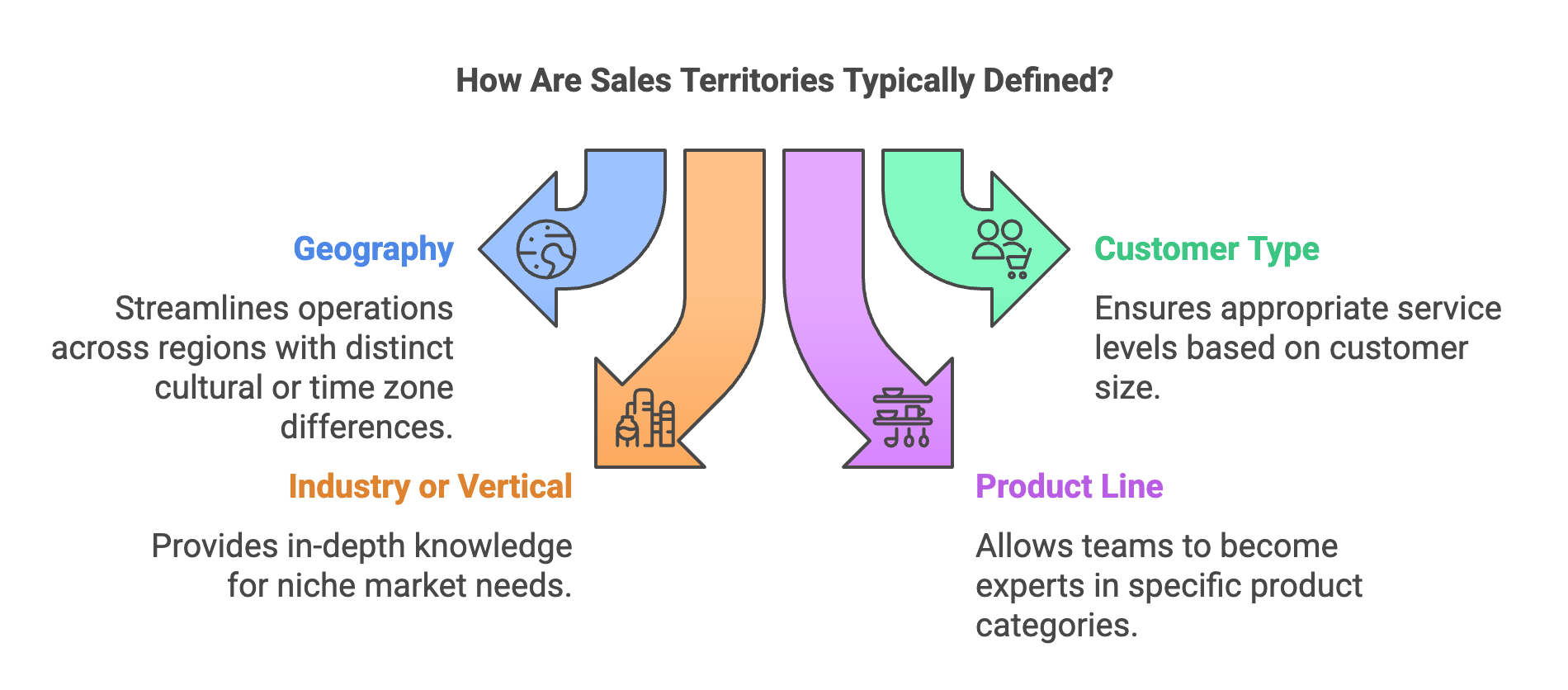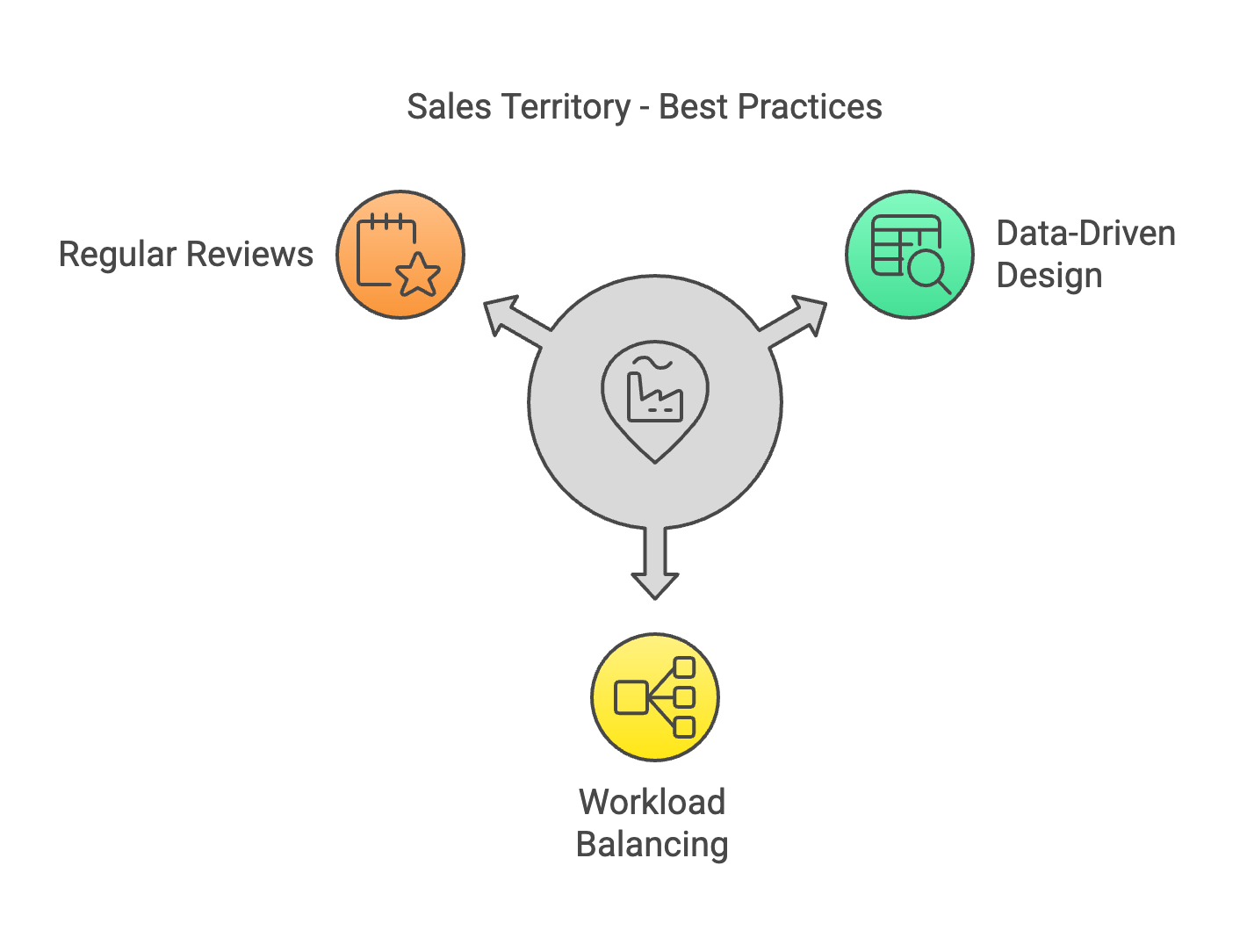- Home
- Sales Operations
- Sales Territory
What Is a Sales Territory?
What is a sales territory?
A sales territory is more than just a geographic area—it’s a strategic way to organize and focus your sales efforts.
Think of it like dividing a large pie into slices so everyone gets their share. Sales territories allow businesses to segment their market into manageable portions, enabling efficient resource allocation and ensuring that every potential customer deserves attention.
Territories can be defined in various ways, such as geography (e.g., a city, state, or country), customer type (e.g., small businesses, large enterprises), industry (e.g., healthcare, technology), or even product lines.
We explore how sales territories are defined, their purpose and benefits, how they should be designed, managed, and optimized, and finally, why they’re crucial to any successful sales strategy.
What Is A Sales Territory and
How Are Sales Territories Typically Defined?

Sales territories can be structured based on several characteristics, depending on a company’s strategy and customer needs:
- Geography
Companies with a global or regional presence, such as Coca-Cola, often define territories by geographical boundaries. For example, they may assign one team to North America and another to Europe. This method helps streamline operations, primarily when significant cultural differences or time zones exist. - Customer Type
A B2B SaaS company like Salesforce might define territories based on customer size—small businesses, mid-sized companies, or enterprises. This approach ensures that customers receive the right level of service and expertise. - Industry or Vertical
Businesses targeting niche markets, such as medical equipment manufacturers, might assign sales teams to specific industries like hospitals, clinics, or research facilities. This ensures salespeople have in-depth knowledge of their customer’s specific needs. - Product Line
A company with a diverse product portfolio, such as 3M, might organize territories by product categories, like industrial adhesives versus personal protective equipment. This allows sales teams to become product experts.
The choice of characteristics depends on a company’s goals. For example, a business focused on rapid market penetration may prioritize geography, while one targeting long-term customer relationships might focus on customer types.
What Is A Sales Territory?
Purpose and Benefits
Sales territories are vital for streamlining sales processes and achieving business goals. Here’s why they matter and how they can improve sales performance:
- Resource Optimization
By dividing the market into territories, companies can cover every potential customer without overlapping efforts. For example, a pharmaceutical company like Pfizer might assign specific regions to its sales reps to avoid multiple reps competing for the same doctors. - Enhanced Customer Relationships
Focusing attention on a specific territory allows salespeople to develop stronger customer relationships. For instance, a luxury car brand like BMW might allocate high-net-worth customers in metropolitan areas to their most experienced sales reps. - Better Performance Tracking
Territories make it easier to set clear goals and measure performance. A retail chain like Target could track the sales performance of its regional managers to identify top-performing areas and replicate strategies.
How Should Sales Territories Be Designed, Managed, and Optimized?

Designing and managing sales territories effectively requires strategic planning, ongoing monitoring, and continuous improvement.
Here are three best practices:
- Use Data to Define Territories
Territories should be based on data like market potential, customer demographics, or historical sales trends. For example, a real estate company might analyze local property demand before assigning territories to agents. - Balance Workloads Equitably
Ensure territories are evenly distributed in terms of opportunity to avoid overloading some sales reps while under-utilizing others. A telecom company like Verizon might balance territories by customer density and average revenue per customer. - Regularly Review and Adjust
Markets change, and sales territories should adapt accordingly. Conduct periodic reviews to ensure territories align with current business goals. For instance, an e-commerce company like Amazon might reassess territories during peak seasons to focus on high-demand regions.
What Is A Sales Territory And
Why It's Crucial in a Sales Strategy?
Sales territories are essential to a successful sales strategy because they provide structure, balance workloads, and ensure efficient market coverage.
By dividing the market into manageable segments, businesses can assign clear responsibilities to their sales teams, reducing overlaps and avoiding missed opportunities.
It keeps things fair, avoids overlap, and helps your team build stronger relationships with the customers they know best.
Tracking progress is a breeze, so you can see what’s working and keep improving.
With well-designed sales territories, your team can work smarter, hit their goals, and always deliver outstanding results!
What Is a Sales Territory? -
Summary
A sales territory is like a well-mapped plan for your sales team. It divides the market into manageable sections so everyone knows exactly where to focus their efforts.
Whether defined by geography, customer type, industry, or product lines, territories make connecting with customers in meaningful ways easier.
They help businesses use resources wisely, avoid overlap, and build stronger client relationships.
When designed thoughtfully—using data, balancing workloads, and staying flexible as markets evolve—sales territories boost efficiency, track progress, and keep everything running smoothly.
At the heart of any successful sales strategy are sales territories, which provide the structure and focus needed to achieve great results while ensuring that every customer feels valued.
By clearly defining sales territories, tailoring them to company needs, and optimizing them over time, businesses can unlock the full potential of their sales teams, drive revenue growth, and build lasting customer relationships.


